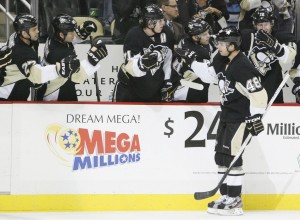
The downfall of the Pittsburgh Penguins can be traced back to the summer of 2012. During that summer and prior to the beginning of the NHL season there were a number of roster changes via trade and free agency.
Two changes were made by then general manager Ray Shero set forth a chain of events contributing to the downfall of the Pittsburgh Penguins. During the summer of 2012 the changing roles/locations of Jordan Staal and Pascal Dupuis would become pivotal to the future of the franchise.
Revolving door
Players leaving that summer included Jordan Staal, Zbynek Michalek, Ben Lovejoy, Brian Strait, Aaron Asham and Steve Sullivan. While the players acquired were Brandon Sutter, Brian Dumoulin, Harrison Ruopp, Marc Cheverie, Tomas Vokoun, Jeff Zatkoff and Tanner Glass.
The Penguins gave up two top six forwards (Staal/Sullivan), one bottom six forward (Asham) and two depth defensemen (Lovejoy/Strait). While they brought in two bottom six forwards (Sutter/Glass), a backup goaltender (Zatkoff), a 1A goaltender (Vokoun) and a collection of prospects.

The third line went from Jordan Staal, Pascal Dupuis and Matt Cooke to a combination of Brandon Sutter, Matt Cooke and Tyler Kennedy. Both Sutter and Kennedy were definite downgrades from their predecessors and moving Kennedy up in the lineup resulted in the cracks beginning to show in terms of depth in the forward ranks.
Loss of depth
With the loss of two top six forwards the depth of the Penguins was greatly reduced. Prior to the 2012-13 NHL season Pascal Dupuis had been tremendously effective in a bottom six role. He played the majority of the 2011-12 season on a line with Jordan Staal and Matt Cooke. After the summer of 2012 he was thrust into a top six role playing alongside Sidney Crosby and Chris Kunitz.
This change of moving Dupuis into the top six then shifted the likes of Tyler Kennedy, Tanner Glass, Craig Adams and Joe Vitale into more prominent roles in the bottom six forward grouping. They are all serviceable players, but not in the above average category of bottom six players to be sure.

Comparing the Penguins over the past four seasons
There are some key indicators that greatly contribute to winning teams. If you are not outscoring your opponents then you are not likely to win many if any games, therefore goals for percentage is a key statistic in winning. Along with that a combination of Fenwick for percentage and offensive zone starts percentage show whether a team is able to move the play up ice and spend more time in the opposing team’s zone.
All three of these statistics a combined are generally very accurate in coinciding with winning teams. It is also clear once looking at them for the Penguins that there was a definite change in the team after the summer of 2012.
Most successful franchises
From 2010 to 2012 the top five teams in this combined Team Rating statistic were Detroit, Boston, Pittsburgh, Vancouver and San Jose. Between those five teams they combined for 19 playoff rounds, two Stanley Cup Finals appearances and one Stanley Cup victory.
Between 2012 and 2014 the top five were Chicago, Boston, Los Angeles, St. Louis and the Rangers. They combined for 28 playoff rounds, four Stanley Cup Finals appearances and two Stanley Cup victories.
Change in Pittsburgh
From 2010 to 2012 the Penguins were in fourth place, so where did they fall to from 2012 to 2014? All the way down to 13th place in the NHL by Team Rating. There were two key differences that led to this drop. Their Fenwick for dropped from 53.5% to 49.5% and their offensive zone starts went from 32.2% to 29.7%. The majority of that difference moved into defensive zone starts rising from 27.7% to 31.2%.
These numbers can be analyzed in a variety of ways. In the simplest of terms the Pittsburgh Penguins became a worse possession team and spent more time in their own zone as a result.

It is interesting to note that their goals for actually rose from 53.8% to 54.2% during that time as well. To me that indicated that their top six forwards were better at producing goals from 2012 to 2014, however the drop in possession indicates a lack of depth in the forward ranks.
Evidence of the lack of depth
This is very evident when looking at the Fenwick for numbers for the Penguins forwards between 2012 and 2014. The only forwards above 50% were the top six; everyone else was below this level. If you go back and look at the period of 2010 to 2012 the Penguins were 12 forwards deep at over 50% Fenwick for.
With this clear change in the quality of the Penguins how were they able to maintain their successful regular seasons? From 2010 to 2012 they ranked second behind only the Vancouver Canucks with 216 regular season points and the next two years they dropped to third with 181 points behind the Chicago Blackhawks and Anaheim Ducks.
The combination of their top six forwards producing for more offense and their save percentage moving from 0.918 to 0.924 helped the Penguins to remain and elite regular season team. However depth is extremely important in the post season and this would be their undoing each year.
Looking to the future
Newly minted general manager Jim Rutherford’s number one priority should be to rebuild the depth on this team. The top six forwards are in good shape, it is those bottom two lines that are in rough shape and require repairs.
Rest assured Pittsburgh Penguins fans, all Jim Rutherford needs to do is make small tweaks to the Penguins. Rumours indicate the biggest moves being considered are trading James Neal and Marc-Andre Fleury, while signing a goaltender like Ryan Miller.
Final thoughts
At the end of the day the Penguins have a netminder that has won a Stanley Cup before and he can do it again. With increased depth it will take the pressure off Crosby, Malkin and Fleury to carry the team. The Penguins are in desperate need of returning to their “fun” culture and I have no doubt that Jim Rutherford is up to the task.

Dupuis definitely played on the top two lines prior to 2012-13. However with the Penguins losses via trade/free agency it become a requirement for him to play in the top six, rather than a choice. There was not the depth that they had in years past to rotate him out of the top six when the situation called for it. This is definitely not meant as a knock against Dupuis as a player, however to illustrate that the lack of depth reduced the choices Bylsma would have to work with in making his lineup. Thanks for your comments.
The reason Dupuis played with Staal in 2011-12 was because Staal was a Top 6 forward that season while Crosby was out for most of the year. The top line was Kunitz-Malkin-Neal and the 2nd line was Cooke-Staal-Dupuis. But during the times that Crosby did play that year, his most frequent linemates were still Dupuis and Kunitz. Dupuis had been playing in the Top 6 the previous season as well, when healthy they were using a 1st line of Kunitz-Crosby-Dupuis in 2010-11. He hasn’t played a Bottom 6 role since 2009-10, and even then he still spent quite a bit of time skating with Top 6 linemates. And through most of the 2008-09 season (until they traded for Kunitz and Guerin) he was skating on the top line with Crosby. So they didn’t jsut wake up one day and decide to make him a Top 6 winger in 2012-13.